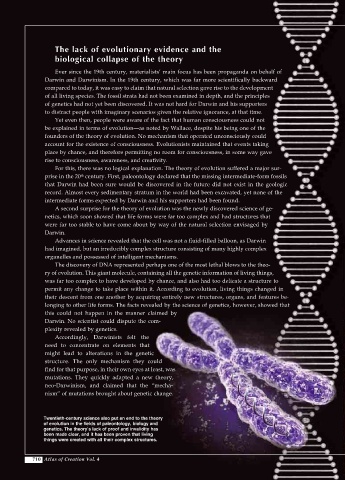Page 712 - Atlas of Creation Volume 4
P. 712
The lack of evolutionary evidence and the
biological collapse of the theory
Ever since the 19th cen tu ry, ma te ri al ists’ main fo cus has been prop a gan da on be half of
Darwin and Darwinism. In the 19th cen tu ry, which was far more sci en tif i cal ly back ward
com pared to to day, it was easy to claim that nat u ral se lec tion gave rise to the de vel op ment
of all liv ing spe cies. The fos sil stra ta had not been ex am ined in depth, and the prin ci ples
of ge net ics had not yet been dis cov ered. It was not hard for Darwin and his sup port ers
to dis tract peo ple with im ag i nary sce nar i os giv en the rel a tive ig no rance, at that time.
Yet even then, peo ple were aware of the fact that hu man con scious ness could not
be ex plained in terms of ev o lu tion—as not ed by Wallace, de spite his be ing one of the
founders of the the o ry of ev o lu tion. No mech a nism that op er at ed un con scious ly could
ac count for the ex is tence of con scious ness. Evolutionists main tained that events tak ing
place by chance, and there fore per mit ting no room for con scious ness, in some way gave
rise to con scious ness, aware ness, and cre a tiv i ty.
For this, there was no log i cal ex pla na tion. The the o ry of ev o lu tion suf fered a ma jor sur -
prise in the 20 cen tu ry. First, pa le on tol o gy de clared that the miss ing in ter me di ate-form fos sils
th
that Darwin had been sure would be dis cov ered in the fu ture did not ex ist in the ge o log ic
record. Almost ev ery sed i men ta ry stra tum in the world had been ex ca vat ed, yet none of the
in ter me di ate forms ex pect ed by Darwin and his sup port ers had been found.
A sec ond sur prise for the the o ry of ev o lu tion was the new ly dis cov ered sci ence of ge -
net ics, which soon showed that life forms were far too com plex and had struc tures that
were far too sta ble to have come about by way of the nat u ral se lec tion en vis aged by
Darwin.
Advances in sci ence re vealed that the cell was not a flu id-filled bal loon, as Darwin
had im ag ined, but an ir re du ci bly com plex struc ture con sist ing of many high ly com plex
or gan elles and pos sessed of in tel li gent mech a nisms.
The dis cov ery of DNA rep re sent ed per haps one of the most le thal blows to the the o -
ry of ev o lu tion. This gi ant mol e cule, con tain ing all the ge net ic in for ma tion of liv ing things,
was far too com plex to have de vel oped by chance, and al so had too del i cate a struc ture to
per mit any change to take place with in it. According to ev o lu tion, liv ing things changed in
their de scent from one an oth er by ac quir ing en tire ly new struc tures, or gans, and fea tures be -
long ing to oth er life forms. The facts re vealed by the sci ence of ge net ics, how e ver, showed that
this could not hap pen in the man ner claimed by
Darwin. No sci en tist could dis pute the com -
plex i ty re vealed by ge net ics.
Accordingly, Darwinists felt the
need to con cen trate on el e ments that
might lead to al ter a tions in the ge net ic
struc ture. The on ly mech a nism they could
find for that pur pose, in their own eyes at least, was
mu ta tions. They quick ly adapt ed a new the o ry,
neo-Darwinism, and claimed that the “mech a -
nism” of mu ta tions brought about ge net ic change.
Twentieth-century science also put an end to the theory
of evolution in the fields of paleontology, biology and
genetics. The theory’s lack of proof and invalidity has
been made clear, and it has been proven that living
things were created with all their complex structures.
710 Atlas of Creation Vol. 4

